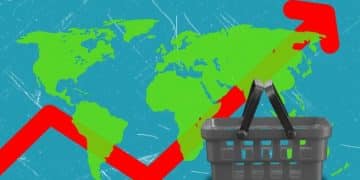What’s Driving 7% Small Business Loan Rate Hike & How to Navigate It?

The recent 7% surge in small business loan interest rates is primarily driven by inflation, Federal Reserve policy tightening, and increased credit risk, demanding a strategic reappraisal of financing and operational capital management by entrepreneurs.
Understanding what’s driving the 7% increase in small business loan interest rates and how to navigate it has become a critical challenge for entrepreneurs across the US. This significant jump isn’t merely an arbitrary fluctuation; it reflects complex economic forces impacting the cost of capital, making strategic financial planning more essential than ever for sustained business growth and stability.
The Macroeconomic Forces Behind Rising Rates
The current economic climate, marked by persistent inflation and the Federal Reserve’s response, serves as the primary catalyst for the escalating costs of borrowing. Small businesses, often relying on loans for expansion, inventory, or operational cash flow, find themselves at the sharp end of these larger macroeconomic shifts. Dissecting these forces is key to comprehending the present landscape.
The Federal Reserve’s dual mandate includes maintaining maximum employment and price stability. In an inflationary environment, where consumer prices are rising rapidly, the Fed’s primary tool to cool down the economy is to increase the federal funds rate. This benchmark rate directly influences the prime rate, which banks use to set interest rates for various loans, including those extended to small businesses. Consequently, higher Fed rates translate almost immediately into higher borrowing costs for businesses.
Inflationary Pressures and Consumer Spending Patterns
Inflation erodes the purchasing power of money, and lenders adjust their interest rates upwards to compensate for this erosion. If inflation is at 5%, a lender charging 2% effectively loses money on the loan’s real return. Therefore, a 7% increase in small business loan rates often indicates a significant inflationary environment where lenders are seeking to protect their returns from being devalued by rising prices. This directly impacts how businesses budget and plan for capital expenditures.
- Input Cost Increases: Higher inflation means businesses pay more for raw materials, labor, and transportation, increasing their need for working capital.
- Reduced Consumer Demand: As inflation squeezes household budgets, consumer spending on non-essentials may decline, impacting revenue for many small businesses.
- Wage-Price Spiral Concerns: The fear of a wage-price spiral—where rising wages chase rising prices—can prompt central banks to act more aggressively, leading to steeper rate hikes.
Understanding the interplay between these factors provides a clearer picture of why loan rates are on the ascent. It’s not just about central bank decisions; it’s about a comprehensive reaction to the economic environment.
Federal Reserve Policy: The Domino Effect
The Federal Reserve’s monetary policy decisions are arguably the most influential factor in determining interest rates. By adjusting the federal funds rate, the Fed sends a clear signal to the financial markets, which then ripple through the entire economy, affecting everything from mortgages to small business loans. This direct linkage makes Fed announcements critical for businesses trying to anticipate future borrowing costs.
When the Fed raises its target rate, commercial banks face higher costs for borrowing from each other, which they then pass on to their customers. This direct pass-through mechanism means that small businesses, often seen as higher-risk borrowers, experience these increases more acutely. The consistency and magnitude of these rate hikes over recent periods have directly contributed to the observed 7% increase.
Impact on Lender Risk Assessment
Beyond the direct influence on base rates, Fed policy also affects how lenders perceive risk. In an environment of rising rates and potential economic slowdown, banks may become more cautious in their lending practices. This can result in stricter lending criteria, higher collateral requirements, and a general tightening of credit availability, alongside the higher interest rates.
- Increased Default Risk: Higher interest rates can stress existing borrowers, potentially increasing default rates, which lenders factor into new loan pricing.
- Reduced Lending Appetite: Economic uncertainty caused by aggressive rate hikes can lead banks to reduce their overall lending appetite, prioritizing lower-risk ventures.
- Credit Score Scrutiny: Lenders may intensify their scrutiny of small business credit scores and personal guarantees, making it harder for some to qualify for favorable terms.
These policy-driven impacts create a challenging environment where businesses not only face higher costs but also potentially reduced access to the capital they need to operate and grow. Navigating this requires a robust financial strategy and a proactive approach to securing funding.

Credit Risk Premium and Small Business Lending
Small businesses, by their very nature, often present a higher credit risk to lenders compared to larger, more established corporations. This perceived risk directly translates into a “credit risk premium” added to the base interest rate. In the current economic climate, particularly with the combined effects of inflation and rising benchmark rates, this premium has likely widened, contributing significantly to the 7% increase in loan interest rates.
Lenders evaluate a range of factors when assessing a small business loan applicant, including their business model, industry stability, cash flow, debt-to-equity ratio, and the owner’s personal credit history. When economic conditions become less predictable, as they are now, the perceived risk associated with these factors rises. Lenders aim to mitigate this increased risk by charging higher interest rates, ensuring they are compensated for the potential exposure to defaults or late payments.
Understanding Lender Risk Factors
Several specific factors contribute to how lenders quantify credit risk for small businesses. A strong understanding of these can help entrepreneurs present a more favorable financial picture. Weaknesses in these areas will invariably lead to higher interest rates or even loan rejection.
- Uncertain Economic Outlook: A general sense of economic uncertainty, driven by inflation or geopolitical events, makes lenders more cautious.
- Industry-Specific Risks: Some industries are inherently more volatile or sensitive to economic downturns, potentially leading to higher rates for businesses within those sectors.
- Business Longevity and Profitability: Younger businesses or those with inconsistent profit margins may be seen as higher risk, regardless of broader economic conditions.
It is not just about the external economic environment, but also about the internal financial health and stability of the individual small business. Lenders apply a microscopic lens to these elements, and any perceived vulnerability contributes to the overall risk premium and, consequently, the interest rate.
Navigating the Higher Interest Rate Environment for Small Businesses
For small businesses, the 7% interest rate hike is not just a statistical anomaly; it’s a direct threat to profitability and growth. Successfully navigating this environment requires a proactive and multi-faceted approach, focusing on both internal financial management and strategic external engagement with lenders. Ignoring these changes could lead to significant financial strain.
Maintaining strong financial health is paramount. This includes optimizing cash flow, reducing unnecessary expenses, and improving overall operational efficiency. Every dollar saved on overhead or generated through improved sales acts as a buffer against higher borrowing costs. Businesses need to re-evaluate their current debt load and future financing needs with a critical eye, considering all possible scenarios under elevated interest rates.
Strategic Financial Management in a Tight Market
Adapting financial strategies is no longer optional but a necessity. This involves revisiting business plans, forecasting models, and potentially exploring alternative financing options that may be less susceptible to interest rate fluctuations or better aligned with the business’s risk profile.
- Boost Cash Reserves: Building a healthy cash reserve provides a cushion against unforeseen expenses and reduces immediate reliance on high-interest loans.
- Refinance Existing Debt: Explore options to refinance existing loans with high variable rates into fixed-rate loans, if available and financially sensible, to lock in costs.
- Optimize Inventory Management: Reduce holding costs and free up capital by implementing Just-In-Time (JIT) inventory systems where feasible.
By implementing these strategies, small businesses can mitigate some of the immediate impacts of higher rates, positioning themselves for greater resilience and potentially creating opportunities even in a challenging market. The key is agility and forward-thinking financial prowess.
Alternative Financing Options and Best Practices
With traditional small business loans becoming more expensive, exploring alternative financing options is a prudent step for many entrepreneurs. The lending landscape is diverse, offering solutions beyond conventional bank loans that might better suit specific business needs, especially those with unique cash flow patterns or asset bases. Diversifying funding sources can also reduce dependence on susceptible, rate-sensitive products.
One increasingly popular option is invoice factoring or accounts receivable financing, which allows businesses to convert their outstanding invoices into immediate cash. While typically coming with a fee, it provides quick liquidity without incurring debt. Another avenue is revenue-based financing, where lenders advance capital in exchange for a percentage of future revenues, often appealing to businesses with predictable sales but limited collateral.
Exploring Diverse Capital Sources
Beyond these, numerous other options cater to different business profiles and needs. Understanding the terms, costs, and suitability of each is crucial before committing. Some alternatives are better suited for short-term needs, while others can support longer-term growth initiatives.
Detailed Analysis of Key Alternatives:
- SBA Loans: Government-backed loans (e.g., SBA 7(a), SBA 504) through the Small Business Administration often have lower interest rates and more flexible terms than conventional bank loans, as a portion of the loan is guaranteed by the government.
- Business Lines of Credit: Provides flexible access to funds up to a certain limit, allowing businesses to draw and repay as needed, ideal for managing working capital fluctuations.
- Equipment Financing: Specifically designed for purchasing business equipment, these loans use the equipment itself as collateral, often leading to competitive rates and specific payment schedules.
- Crowdfunding Platforms: For businesses with compelling stories or innovative products, equity crowdfunding or reward-based crowdfunding can generate capital directly from individual investors or customers.
- Microloans: Smaller loans, often provided by non-profit organizations, designed for very small businesses or startups who may struggle to qualify for traditional bank loans, frequently with lower interest rates.
Each option carries its own set of advantages and disadvantages regarding cost, repayment structure, and qualification criteria. Diligent research and financial modeling are indispensable to ensure the chosen financing aligns with the business’s strategic objectives and short-term liquidity requirements. Seek professional advice to navigate these complex choices.
Optimize Operations and Enhance Profitability
While managing financing costs is crucial, equally important is the internal optimization of business operations to enhance profitability. Increased efficiency and cost control can offset higher interest expenses, making the business more resilient to economic headwinds. This involves a deep dive into every aspect of the business, from supply chain to customer service.
Reviewing and renegotiating contracts with suppliers, implementing energy-saving measures, and automating routine tasks can significantly reduce operating costs. Furthermore, analyzing pricing strategies to ensure they adequately cover rising expenses while remaining competitive is vital. Small adjustments across multiple operational areas can lead to substantial bottom-line improvements, directly alleviating the pressure from elevated interest rates.
Strategies for Operational Efficiency
A continuous improvement mindset should be adopted, constantly seeking ways to do more with less, without compromising quality or customer satisfaction. This might involve investing in new technologies, reorganizing workflows, or cross-training employees for greater flexibility.
- Cost-Cutting Measures: Identify and eliminate non-essential expenses, renegotiate supplier contracts, and explore bulk purchasing discounts.
- Revenue Diversification: Explore new product lines, service offerings, or market segments to broaden revenue streams and reduce reliance on a single source.
- Customer Retention & Expansion: Focus on loyalty programs and excellent service to retain existing customers, as acquiring new ones is often more expensive. Simultaneously, explore opportunities to expand your customer base through targeted marketing efforts.
By focusing on robust internal control and strategic operational enhancements, small businesses can create a buffer against external economic pressures, making them less vulnerable to the fluctuations in loan interest rates. The goal is to build a lean, adaptable, and highly profitable enterprise that can thrive in any economic climate, regardless of borrowing costs.

| Key Area | Brief Strategy |
|---|---|
| 📈 Economic Drivers | Understand inflation and Fed policy impact on rates. |
| 🏦 Lender Risk | Improve business credit, manage cash flow. |
| 💰 Financing Options | Explore SBA loans, lines of credit, factoring. |
| ⚙️ Operational Efficiency | Cut costs, diversify revenue, focus on retention. |
Frequently Asked Questions About Small Business Loan Rates
The 7% increase is driven primarily by sustained inflation, which prompts the Federal Reserve to raise benchmark interest rates. Lenders then pass these higher costs onto borrowers, including small businesses, to maintain profitability and account for increased credit risk in an uncertain economic environment. This also reflects a tightening of monetary policy.
A 7% rate hike significantly increases your monthly loan payments, directly reducing available cash flow. This means less money for operations, inventory, or growth initiatives. Businesses with variable-rate loans will feel this impact immediately, necessitating tighter budgeting and potentially cost-cutting measures to adapt to higher debt servicing costs.
Consider options like SBA loans (often lower rates, government-backed), business lines of credit for flexibility, invoice factoring for immediate liquidity against receivables, or equipment financing. Explore crowdfunding or microloans for specific needs. Each option has unique terms, so assess carefully which best fits your business’s financial health and goals to mitigate high interest rates.
To improve eligibility, focus on strengthening your business’s financial health: maintain a strong credit history (both personal and business), ensure consistent cash flow, reduce existing debt, and build robust financial statements. Showing a clear and stable repayment capacity through strong financial performance makes your business a less risky proposition for lenders, potentially leading to more favorable terms.
The future trajectory of interest rates depends heavily on inflation trends and the Federal Reserve’s response. If inflation remains elevated, further rate hikes are possible. Conversely, if inflation shows signs of cooling or the economy weakens significantly, the Fed might pause or even cut rates. Businesses should monitor economic indicators and Fed announcements closely to anticipate future changes and adapt their strategies.
Conclusion
The 7% surge in small business loan interest rates is a direct reflection of current macroeconomic forces, primarily inflation and the Federal Reserve’s response to it. For entrepreneurs, this environment demands more than just awareness; it requires strategic adaptation, meticulous financial management, and a willingness to explore a spectrum of financing alternatives. By understanding the underlying drivers, optimizing internal operations, and wisely navigating the lending landscape, small businesses can not only mitigate the impact of rising costs but potentially find new avenues for resilience and growth, even in challenging economic times. Proactivity and an informed approach are the keys to thriving amidst these financial shifts.





